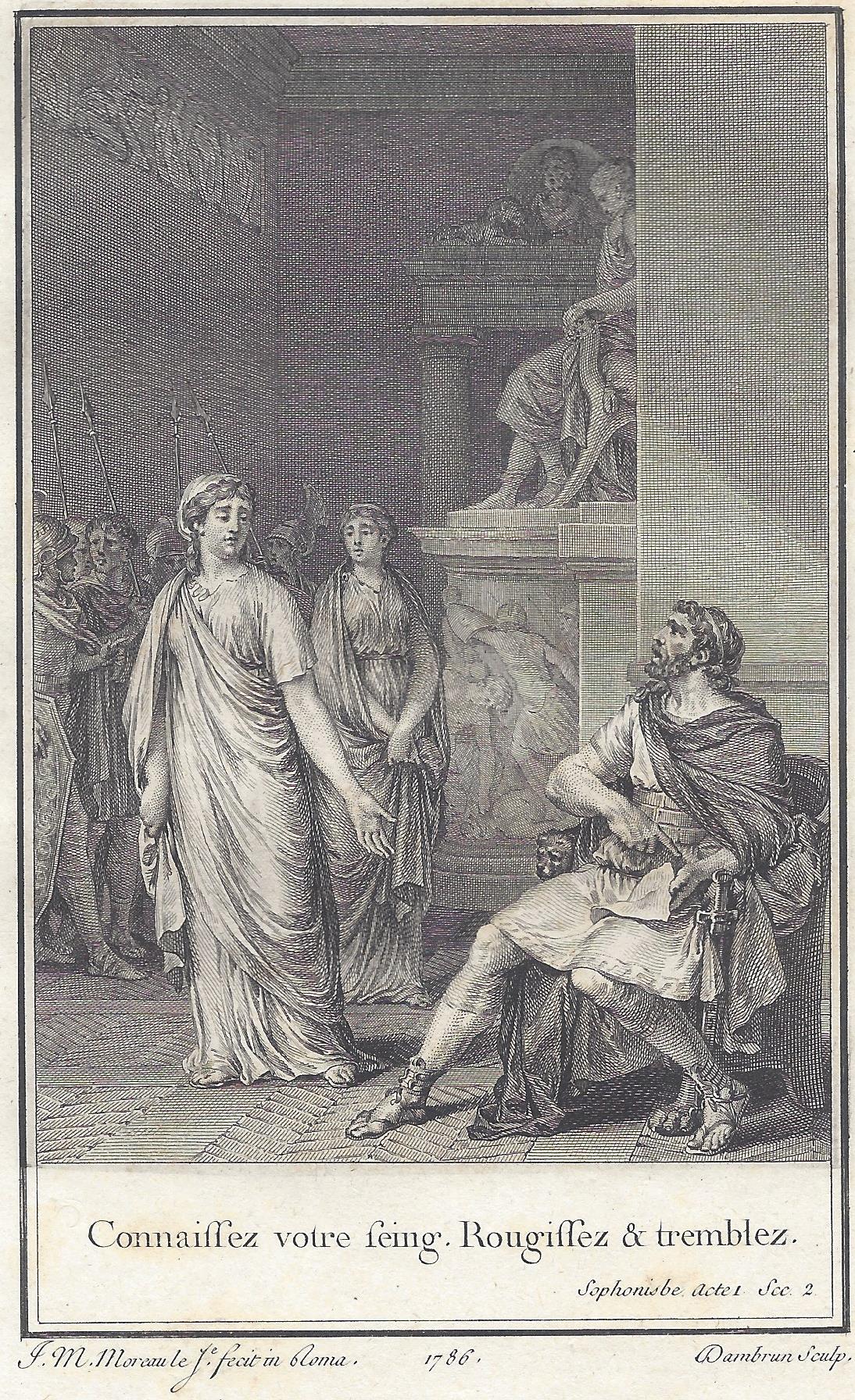Sophonisbe (tragedy) on:
[Wikipedia]
[Google]
[Amazon]
 '' Sophonisbe '' is a tragedy in five acts by
'' Sophonisbe '' is a tragedy in five acts by
full text of ''Sophonisbe''
scanned version of first edition
Literature on ''Sophonisbe'', Société des Etudes Voltairiennes
Plays by Voltaire Tragedy plays 1774 in France 1774 plays Works set in Carthage Cultural depictions of Sophonisba
 '' Sophonisbe '' is a tragedy in five acts by
'' Sophonisbe '' is a tragedy in five acts by Voltaire
François-Marie Arouet (; 21 November 169430 May 1778), known by his ''Pen name, nom de plume'' Voltaire (, ; ), was a French Age of Enlightenment, Enlightenment writer, philosopher (''philosophe''), satirist, and historian. Famous for his wit ...
. The play, printed in 1769 but dated 1770, was a stage failure when it premiered on 15 January 1774.
Action
The action takes places in a hall of the palace ofCirta
Cirta, also known by #Names, various other names in classical antiquity, antiquity, was the ancient Berbers, Berber, Punic people, Punic and Roman Empire, Roman settlement which later became Constantine, Algeria, Constantine, Algeria.
Cirta was ...
at the time if the Second Punic War
The Second Punic War (218 to 201 BC) was the second of Punic Wars, three wars fought between Ancient Carthage, Carthage and Roman Republic, Rome, the two main powers of the western Mediterranean Basin, Mediterranean in the 3rd century BC. For ...
. Sophonisbe, daughter of Asdrubal ( Hasdrubal) is married to king Siphax (Syphax
Syphax (, ''Sýphax''; , ) was a king of the Masaesyli tribe of western Numidia (present-day Algeria) during the last quarter of the 3rd century BC. His story is told in Livy's ''Ab Urbe Condita'' (written c. 27–25 BC).
) of Numidia
Numidia was the ancient kingdom of the Numidians in northwest Africa, initially comprising the territory that now makes up Algeria, but later expanding across what is today known as Tunisia and Libya. The polity was originally divided between ...
. Her former fiancé Massinisse (Massinissa
Masinissa (''c.'' 238 BC – 148 BC), also spelled Massinissa, Massena and Massan, was an ancient Numidian king best known for leading a federation of Massylii Berber tribes during the Second Punic War (218–201 BC), ultimately uniting th ...
) defeats and kills Siphax with the help of the Romans and wants to marry Sophonisbe; Scipion ( Publius Cornelius Scipio Africanus) however wants her sent to Rome. Massinisse therefore kills both Sophonisbe and himself.Vgl. Siegfried Detemple: ''Sophonisbe'', in: ''Voltaire: Die Werke. Katalog zum 300. Geburtstag.'' Reichert, Wiesbaden 1994, pp.220f.
Literary sources
The material for the plot derives from accounts byTitus Livius
Titus Livius (; 59 BC – AD 17), known in English as Livy ( ), was a Roman historian. He wrote a monumental history of Rome and the Roman people, titled , covering the period from the earliest legends of Rome before the traditional founding i ...
, Polybius
Polybius (; , ; ) was a Greek historian of the middle Hellenistic period. He is noted for his work , a universal history documenting the rise of Rome in the Mediterranean in the third and second centuries BC. It covered the period of 264–146 ...
and Appian
Appian of Alexandria (; ; ; ) was a Greek historian with Roman citizenship who prospered during the reigns of the Roman Emperors Trajan, Hadrian, and Antoninus Pius.
He was born c. 95 in Alexandria. After holding the senior offices in the pr ...
, which had already been adapted into stage plays by a number of writers including Gian Giorgio Trissino
Gian Giorgio Trissino (8 July 1478 – 8 December 1550), also called Giovan Giorgio Trissino and self-styled as Giovan Giωrgio Trissino, was a Venetian Renaissance humanist, poet, dramatist, diplomat, grammarian, linguist, and philosopher. ...
(1514), Jean Mairet (1629), Pierre Corneille
Pierre Corneille (; ; 6 June 1606 – 1 October 1684) was a French tragedian. He is generally considered one of the three great 17th-century French dramatists, along with Molière and Racine.
As a young man, he earned the valuable patronage ...
(1663) and Nathaniel Lee (1675). Analysis of the dramatic structure and the verse indicates that Voltaire drew on a number of earlier version of the story while crafting his own.
Contemporary reception
Voltaire succeeded in having the play premiered at the Comédie-Française on 15 January 1774 but there were only four performances before it was taken off the stage. The failure of both this and his other play '' Don Pèdre, roi de Castille'' depressed him, and he took a break from writing tragedies until 1777, when he wrote '' Irène'' and '' Agathocle''.Printed edition
Voltaire had arranged the printing of the work in late 1769 with the widow Duchesne in Paris. Publication followed at the end of that year, carrying the date 1770. The work was published with the title ''Sophonisbe, Tragédie de Mairet, reparée à neuf'', Veuve Duchesne, Paris, 1770. Voltaire added an explanatory preface in which he claimed that Mairet's work had been adapted by a certain Jean-Baptiste Lantin, who had died fifty years previously, but this is certainly spurious. It may be that Voltaire was uncertain about how the theatre-going public would respond to the play, and wished to distance himself to some degree from his own creation.{{cite web , last1=Malone Feige , first1=Camilla , title=Genesis and sources of Voltaire's "Sophonisbe" , url=http://digitallibrary.usc.edu/cdm/ref/collection/p15799coll39/id/281023, website=digitallibrary.usc.edu , publisher=USC Digital Library , access-date=1 November 2018References
External links
full text of ''Sophonisbe''
scanned version of first edition
Literature on ''Sophonisbe'', Société des Etudes Voltairiennes
Plays by Voltaire Tragedy plays 1774 in France 1774 plays Works set in Carthage Cultural depictions of Sophonisba